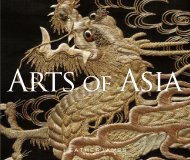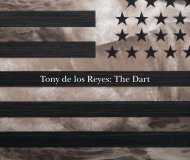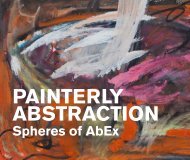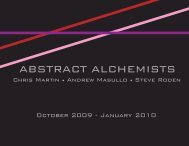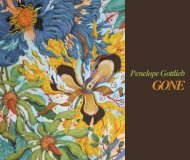EARL CUNNINGHAM: American Fauve - Heather James Fine Art
EARL CUNNINGHAM: American Fauve - Heather James Fine Art
EARL CUNNINGHAM: American Fauve - Heather James Fine Art
Create successful ePaper yourself
Turn your PDF publications into a flip-book with our unique Google optimized e-Paper software.
<strong>EARL</strong> <strong>CUNNINGHAM</strong>’S<br />
SELF-TAUGHT MODERNISM<br />
Robert Hobbs<br />
The paintings of the Maine-born self-taught marine painter Earl Cunningham (1893-1977)<br />
are distinguished for incorporating significant aspects of mainstream modern art, particularly<br />
the high keyed coloristic work of the Post-Impressionist Vincent Van Gogh and the French<br />
<strong>Fauve</strong>s. Known for his visionary scenes of both Maine and Florida, Cunningham created an art<br />
that belies the once widely endorsed view regarding self-taught art’s presumed lack of erudition.<br />
Although he was certainly an autodidact in his art and semi-literate, as his occasionally recorded<br />
personal journal testifies, Cunningham’s work is not lacking in sophistication, and he himself<br />
was not unaware of mainstream avant-garde art developments, as his own art so clearly indicates.<br />
Since the 1920s Cunningham maintained a messianic zeal about his work, an approach<br />
most clearly appreciated by considering his great desire to have a museum devoted to it. 1<br />
Although he might have joked about this imaginary museum, he was also deadly serious about<br />
it and his identity as an artist. Often he would wear a beret as a way of reinforcing his artistic<br />
identity, and when he painted, he would don an artist’s smock with a crest emblazoned on its<br />
back. The crest, with the addition of the words “Over Fork Over,” was the same family seal he<br />
himself had devised and used to advertise the gallery comprised of his paintings, located next<br />
door to his antique shop.<br />
The museum as the legitimate future repository for Cunningham’s paintings can be<br />
credited as a basis for his great desire to achieve a range of subjects in his marines, to create a<br />
wondrous sense of fantasy about the past, and to achieve a subtle and disarmingly charming<br />
critique of the present, thereby representing in his art a renewed symbolic genesis of the<br />
United States’ history. His paintings re-create aspects of an idealized and fanciful past to<br />
provide halcyon views of what America could have been and might still be. In many paintings<br />
Cunningham symbolically reenacts America’s beginnings by bringing early Norse explorers<br />
and Native <strong>American</strong>s together with the late–nineteenth- and early-twentieth-century sailing<br />
vessels of his youth. To reinforce the great antiquity of the Norse ships, the artist would often<br />
paint patches on their sails.<br />
The sense of nostalgia pervading these works is key to the way Cunningham re-presents<br />
the world rather than merely reflecting it. Although the term “memory painter” is often used<br />
for such individuals as Cunningham, in his case it is particularly confusing because it suggests<br />
his creations are mere reflections of his youth rather than highly symbolic, even necessary<br />
reconstitutions of it. Calling him a memory painter trivializes and invalidates his creations,<br />
implying his broad cultural reassessments are merely charming and inaccurate recollections.<br />
preferred to call him an “<strong>American</strong> <strong>Fauve</strong>” after the early twentieth-century group of French<br />
colorists around Henri Matisse. While Cunningham was innocent of such established academic<br />
techniques as one-point perspective and classical ways of rendering human anatomy, he was<br />
sophisticated in employing a number of ideas germane to modern art, so his naiveté was very<br />
knowing.<br />
When Cunningham signed a painting “<strong>American</strong> Primitive” 2 and later when he had<br />
business cards printed with the designation “Primitive <strong>Art</strong>ist,” he set up tensions between<br />
intuitive art and tongue-in-cheek postmodernist practices—those knowingly ironic approaches<br />
often taking specific artistic categories and genres as subjects for their work—and he did so<br />
decades before postmodernist art was developed and ratified as a critical approach. His self<br />
-awareness of his special contradictory status indicates a sophistication at odds with the usual<br />
expectations concerning vernacular artists, and this acute understanding of being both an insider<br />
and an outsider points to the fluidity of language in the twentieth century, when naiveté and<br />
sophistication are not always polarities.<br />
By employing the term “Primitive <strong>Art</strong>ist” to refer to himself, Cunningham doubles the<br />
codes for vernacular art with the goal of employing one to reinforce the other. This designation,<br />
however, which is characteristically used by a member of the mainstream culture to refer to<br />
someone who is marginalized, serves the reverse function in Cunningham’s case of questioning<br />
the authenticity of his work. The doubling of sophisticated and vernacular codes continues to be<br />
evident in his re-appropriation of the so-called folk-art forms employed by many modern artists,<br />
including the <strong>Fauve</strong>s, and in his reliance on the tradition practiced by Edward Hicks, Grandma<br />
Moses, and Joseph Pickett. Depending on one’s point of view, Cunningham’s approach can be<br />
considered an appropriation of modernism, a re-appropriation of the vernacular that modern art<br />
itself had appropriated, a revival of the <strong>American</strong> folk-art tradition as seen in the works of Hicks<br />
and others, and a survival of the nineteenth-century traditions Cunningham himself continues.<br />
Of course, his tactic is representative of all these attitudes, considered singly or in combination.<br />
Although Cunningham was self-taught, he was definitely not naïve; and although he was selfaware<br />
of his status as a vernacular artist, he remained an intuitive painter who attempted to<br />
synthesize his experiences in a visual form. Thus, Cunningham was both marginalized and<br />
mainstream at the same time. Perhaps, because of this contingent status, Cunningham put<br />
a great deal of emphasis on his handmade frames, modeled on nineteenth-century <strong>American</strong><br />
Empire-style ogee ones, so that they were imposing enough to circumscribe and separate his<br />
Left: Earl Cunningham in the gallery of his shop, 1970. Photo by Jerry Uelsmann<br />
13





